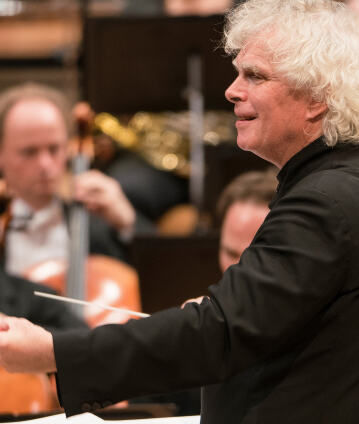Simon Rattle conducts Bruckner’s Eighth Symphony

Anton Bruckner’s Eighth Symphony is not only the composer’s most extensive work, but also one of his most striking. Its tremendous energy derives from the interplay of wave-like climaxes – from the building up of monumental blocks of sound which subside into melancholic brooding. In 2017, Simon Rattle performed the symphony for the first time with the Berliner Philharmoniker. The concert opened with a new short work by Simon Holt.
Simon Holt’s music is full of iridescent timbres and is created with great attention to detail. He has been the Composer in Association of the BBC National Orchestra of Wales for many years. At the beginning of this concert, Sir Simon Rattle premieres a new symphonic “canapé” by the British composer, written in the scope of the Philharmonic “Tapas” series, which consists of commissioned works lasting a maximum of six minutes in performance.
The programme continues with a musical heavyweight, Bruckner’s Eighth Symphony: a truly monumental work that acquires its energy from the interplay of wave-like escalations, the piling up of clearly contoured blocks of sound and a dynamic falling back of the music. It’s not for nothing that Ernst Kurth used the image of the “symphonic wave” to describe Bruckner’s symphonies in his book Music Psychology, which was first published in 1931– a term that aims at the feeling of fluctuating, culminating and relaxing, and at the always new climaxes and ebbs in his music. Furthermore, one can read in Kurth about light and dark shadings, echo sounds and “thinner to fuller layers of sound” – concepts appropriate to describe Bruckner’s Eighth Symphony, whereby in this work, which tends to extremes, a balance is ultimately maintained between static and dramatic gestures despite all the music’s falling into abysses and being restored again: the first theme of the massive first movement (which is followed by two more) evolves from the mysterious sound of “cloudy” horn calls and string tremoli, before in the development the musical forces collide with each other unchecked. At the end there is a resigned coda that gradually dies down in pianissimo.
Bruckner himself wrote in a letter to the conductor Felix Weingartner, referring to the first movement, of a “death announcement which from time to time appears, louder each time, and at the end is very loud: the surrender”. After the Scherzo and its idyllic trio, a conclusion is drawn on the basis of the previous symphonic development: in the sombre Adagio, defined by the dark sound of the Wagner tubas, and in the “solemn” Finale, in which brass cascades pile up over string sounds, before in the development the motivic elements are artfully combined. The thematic shapes from the previous movements are first touched on in the coda, until finally the four contrasting themes are layered to create a huge final apotheosis, entirely in the spirit of Kurth’s “symphonic wave”.
© 2017 Berlin Phil Media GmbH
Artists
Our recommendations
- Simon Rattle and Magdalena Kožená at the Waldbühne
- Simon Rattle conducts Brahms, Lutosławski and Widmann
- “Carmen” with Simon Rattle, Magdalena Kožená and Jonas Kaufmann
- Simon Rattle conducts Schumann, Wagner, Ravel, Debussy and Ligeti
- Dance project: “Carmen”
- “La Damnation de Faust” with Simon Rattle, Joyce DiDonato and Charles Castronovo